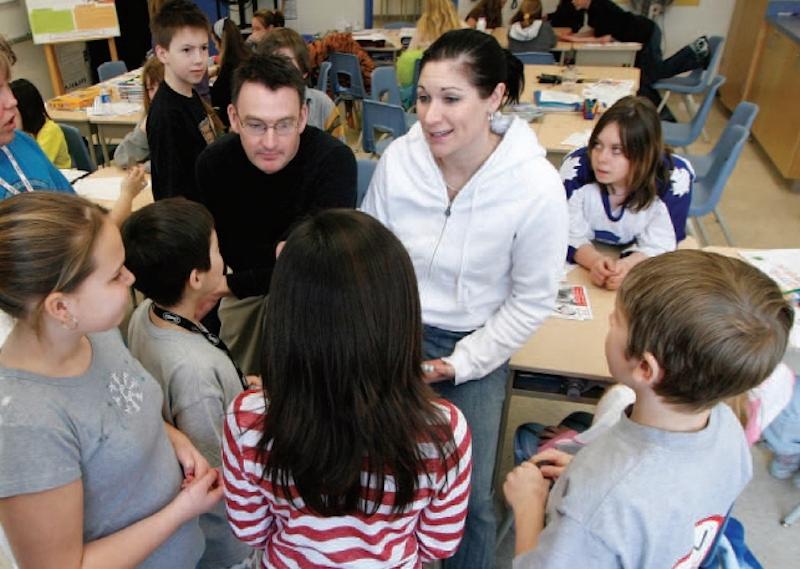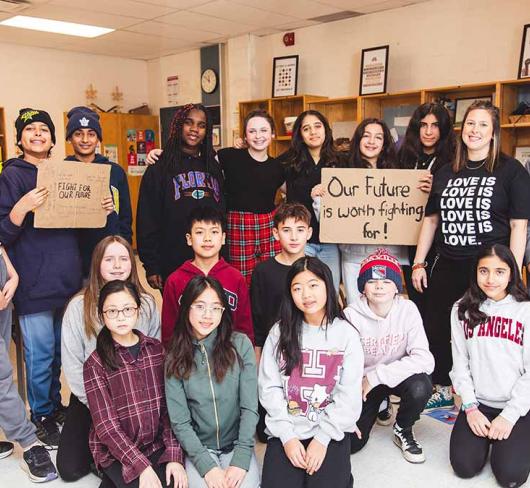
Small Teams with Big Impact: Engaging in Lesson Study
The grade 6 students settle down as the lesson begins. A few scan the room, intrigued by the novel presence of three teachers and one administrator, clipboards in their hands. I begin the lesson; the topic is note taking and summarizing from informational text.
Why was I here? I don’t normally teach grade 6; I teach a grade 7/8 class, along with intermediate history, on rotary. Although I often try to get over to Kim Arbour’s grade 6 classroom to chat, to visit, to see what she and her students are up to, there never seems to be enough time. We squeeze in a few minutes for professional conversations on the fly, waiting by the photocopier, scrambling up the stairs as the bell rings, or perched upon the edges of our students’ desks for an end-of-the-day laugh – or on some days, a rant.
We teachers lead busy lives, often focused on the urgent. We try to steer our conversations toward the important and long-lasting ideas that drew us to teaching in the first place, but the time always seems to fly away. When and how will we be able to have the professional conversations we want and need to have, we wonder. How do we fit our professional interests and concerns into the rush of our school days?
This year, as part of a project funded by our district school board, groups of teachers across our region have been participating in school-based action research designed to facilitate professional conversations to help improve teacher understanding and skill in teaching literacy. At our school, Jersey Public School in Keswick, we have decided to incorporate lesson study into our project, and our focus is on deepening our understanding of the role student engagement plays in the quality of their writing.
Lesson study is a process that originated in Japan. It involves the collaborative planning, teaching, observing and revising of a specific lesson by a team of teachers. It is designed to bring teachers together to observe, first-hand, the impact that a lesson is having on students as the lesson is being taught. The lesson topic is usually drawn from a concern or issue that teachers on the team have identified as important. The team plans the lesson, then one of the members volunteers to teach it while the others watch and record their observations of the students.
This opening up, or “deprivatizing,” of teaching practice is not common in our culture of teaching, and it can make some teachers uncomfortable. With this concern in mind, our lesson study team began with specific activities designed to build our trust in one another, help us understand the dynamics of effective teamwork and develop clear protocols on how we would carry out our research. We were able also to tap into the resources of district-level staff, to help facilitate our project and to ensure we were adhering to the protocols we had established.
At Jersey, we wanted to explore how we could improve our instruction in writing to boost the engagement levels and meet the needs of students who were having difficulty with writing. Our decision to focus on our struggling learners can be traced back to another central idea of lesson study: that we can learn a great deal about how to improve our teaching by looking at what is not working, which is best accomplished as the lesson is being taught.
The simplicity of the lesson study process is what makes it so effective. The observers collect and record data on what they hear and see from the students during the lesson, and these observations form the basis of the conversation the team has after the lesson. Part of that conversation involves revising the lesson, based upon the students’ responses to the activity. After this revision process, the cycle continues, with a new member of the team teaching the revised lesson while the others observe and collect data. Often this revised lesson is taught to a different group of learners. In our case, the fact that our focus was on the effectiveness of our shared writing lessons, and on a specific number of students, prompted us to conduct our research entirely within one team member’s classroom.
We planned a lesson for Kim Arbour’s grade 6 class. The students were working on researching and writing reports on the solar system as part of a cross-curricular science and language unit. We designed a shared reading and writing activity that demonstrated the use of the It Says/I Saysummarizing strategy introduced in When Kid’s Can’t Read – What Teachers Can Do by Kylene Beers. As I taught the lesson the rest of the team – Kim; Shirley Ley, our special education resource teacher; and our vice-principal, Judith Livingston – acted as data collectors.
In the conversation we had after the lesson (with the support of facilitator Wendy Swaine), we were able to reach some conclusions based upon the recorded observations and the student surveys we had collected after teaching. We noticed that there were students who looked as if they were engaged in the lesson, but upon scrutiny of their surveys and observations, we could see that they were not, while a few students who didn’t appear to be engaged in the lesson actually were. We also found we had more questions – many more questions than answers, actually.
Our focus on engagement has led us to consider what engagement means from the perspective of our students. What does it mean to be engaged? What does engagement look like? Sound like? How is it that some learners are able to maintain and monitor their attention during shared writing instruction, while others seem to struggle, losing focus and creating gaps in their skills as writers? These are the professional questions we hope to talk about together as we go through the lesson study process, one lesson at a time.
Working together to study our craft, in the schools and classrooms we teach in, ought to be the foundation of our professional learning as teachers. Studying the impact of the planned instructional decisions we make, as they happen, is a logical context for this learning. As our small team continues on the lesson study journey, we look forward to the new insights and teaching ideas our work together will bring.

